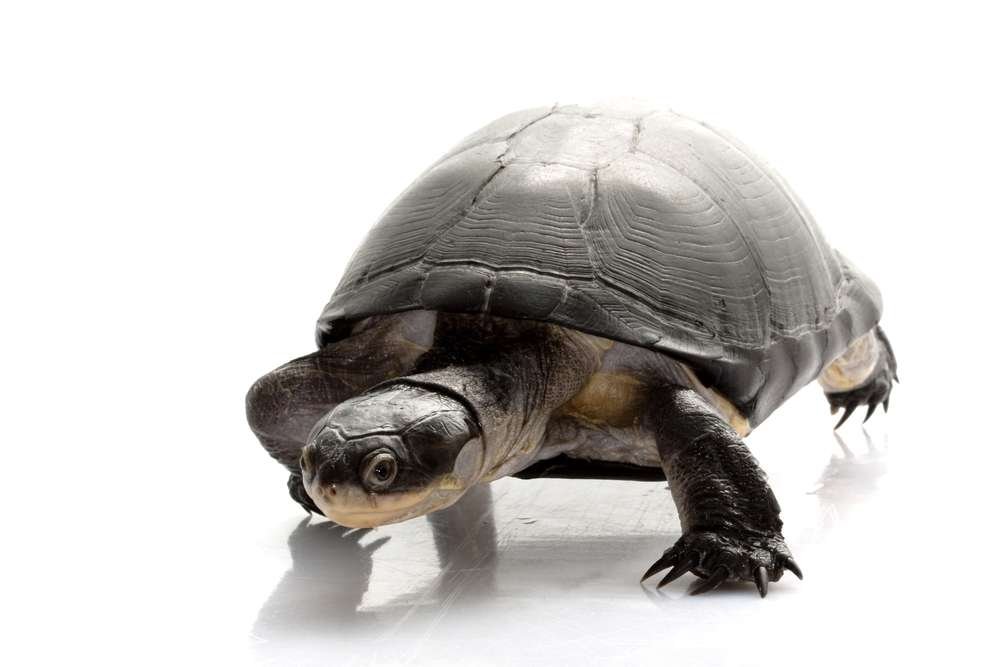Pan Hinged Terrapin
( East African black mud turtle )
- Pelusios subniger
- IUCN Status: Least Concern
- Threat: harmless
- Venom/Toxin: none
- Trend: decreasing

- Phylum: Chordata
- Class: Reptilia
- Order: Testudines
- Suborder: Pleurodira
- Family: Pelomedusidae
- Genus: Pelusios
Share:
General Information
The East Africa black mud turtle is a semi-aquatic turtle that loves to swim and bask in the sun.
Fun Facts!
Turtles and Tortoises are known to be highly intelligent. They can dig under or plan their escape from captivity, they can learn new tricks and remember them for a very long time. Another interesting feature is that they have both an exoskeleton (the shell on the outside) and an endo-skeleton (the bones on the inside).
Description
It is a medium sized turtle which has a smooth, domed carapace. The carapace is typically dark brown, gray, or black, often with yellow or dark markings on the margins. They are rather dull in color like most of their genus. The plastron (under-side shell) is hinged. The underside of the turtle can be brown, grey, black, or yellow. The upper jaw has a blunt, smooth shape. The head of an adult is generally uniform in color. As in all side-necked turtles, the neck retracts the head sideways instead of vertically into the shell.
- Length: 12.7 - 21 cm
- Lifespan: over 50 yrs in captivity and 47 yrs in the wild
Ecology and Behaviour
The East Africa black mud turtle is nocturnal and more active at night though they can be seen basking throughout the day. They have been observed to burrow into the mud to regulate their body temperature. These turtles are easy to handle and are not aggressive towards humans but are highly aggressive towards other turtles
Diet
The East African black mud turtle is omnivorous and takes fish, invertebrates, and plants. They will attack and kill birds, mice, insects and nearly anything else they can get a hold of.
Reproduction
Females lay nests of 3-12 eggs. They lay their eggs in the spring and bury them in mud. Eggs take about two months to hatch.
Conservation
It is categorized by the International Union for Conservation of Nature (IUCN) as, ” Least Concern “
Distribution and Habitat
The East African black mud turtle inhabits marshes, lakes and streams. The species occurs in much of eastern and southeastern tropical and subtropical Africa. In captivity, they can experience skin problems if the Ph of the water is not maintained between 6.0 and 6.5. and a temperature of 25.56 – 27.78 degrees Celcious should be maintained.
Interaction with humans
The African side-necked turtle is popular as a pet because of its unusual head tucking behavior. Currently it is mainly threatened by widespread collection from the wild for the illegal international trade in the species. It is also collected by local peoples for food and human population growth in the area is putting pressure on the species. Human-induced fire is also a threat. In most Zambian cultures, turtles and tortoises are revered and respected by people. It is said that one should never kill a turtle or tortoise without reason. If you are to come across one stuck upside down along your path, it is said to be good luck to help it and turn it over to let it goon its way and that doing the opposite or leaving it stuck is very bad luck and karma.
No donation to this project yet.
| M | T | W | T | F | S | S |
|---|---|---|---|---|---|---|
| 1 | 2 | 3 | 4 | 5 | 6 | 7 |
| 8 | 9 | 10 | 11 | 12 | 13 | 14 |
| 15 | 16 | 17 | 18 | 19 | 20 | 21 |
| 22 | 23 | 24 | 25 | 26 | 27 | 28 |
| 29 | 30 | 31 | ||||


